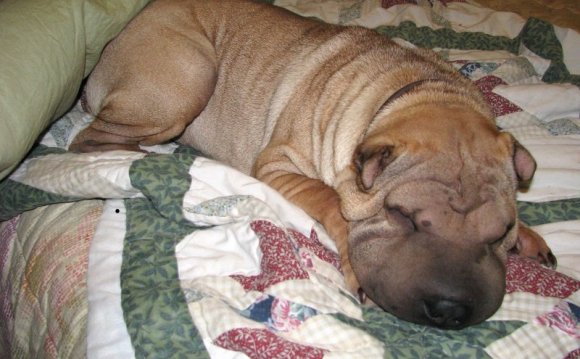
Allergic Dermatitis (Atopy) is probably one of the most frustrating, and certainly most common, genetic ailments in dogs. Sensitivity to environmental allergens like pollen, mold, dander, dust mites, fleas, and chemicals leaves pet parents to wonder if there’s anything their dog isn’t allergic to.
While allergies can develop in any breed, Atopic Dermatitis is genetic and animals with the condition should not be bred. The genetic connection has resulted in many breeds having a predisposition to Atopy, including Belgian Tervurens, Miniature Schnauzers, Labrador & Golden Retrievers, English & Irish Setters, Boxers, Boston Terriers, Pugs, Dalmations, Wirehaired Fox Terriers, Shih Tzus, Lhasa Apsos, Scottish Terriers, West Highland White Terriers, Shar-peis, and Cairn Terriers. Some studies have also indicated a higher instance of Allergic Dermatitis in females.
Symptoms
Symptoms usually appear within 1-3 years of the dog being exposed to the allergens (antigens) and gradually increase in severity. The symptoms may be seasonal in the beginning, but usually progress to all year round. Allergic Dermatitis can torture dogs (and some cats) with itching and inflammation, accompanied by highly sensitive skin, hair loss, and obsessive licking as time goes on. As the condition worsens, chronic secondary bacterial infections may cause lesions, papules (red bumps), pustules (pimples), reddening skin, darkening skin (hyper-pigmentation), or ‘bronzing’ from excessive licking. Secondary yeast infections (usually Malassezia) causes greasy, yellow scaling, redness and foul odor.
Natural Treatment of Allergic Dermatitis
There are many topical and internal natural treatments and remedies to help manage the symptoms of Atopic Dermatitis. There is no actual cure, however, so be highly suspicious of any product claiming to do so.
Diet
The dietary focus may include natural immune system support, anti-histamines, anti-inflammatories, anti-bacterials and anti-fungals. It also includes dietary items to avoid, such as chemicals, by-products, soy-based fillers, and impurities. A natural diet is always recommended, especially when sensitivity or allergies are a consideration. If a food allergy is suspected, a switch of protein source (such as venison, lamb or rabbit), and/or a gluten-free, wheat-free, soy-free or yeast-free diet is often recommended.

Supplements
Supplements may be slowly added to the diet after a bland diet trial (8 weeks). We recommend natural sources to avoid artificial flavoring and other chemicals.
- Orthomolecular Therapy uses vitamin dosing, including vitamins A, C, E (antioxidants) and the mineral Selenium, but should only be used with the guidance of your veterinarian to avoid overdose. To boost these vitamins and minerals naturally, you can safely add 1/2 tsp to 1 tsp of seaweed daily.
- Herbs and Essential Oils: Aloe, alfalfa, dandelion leaves, echinacea, horsetail, burdock root, feverfew, German chamomile, nettle, yarrow, spirulina, yellow dock, red clover, and goldenseal are often recommended as herbal treatments for Allergic Dermatitis symptoms. They should only be used with professional guidance due the risk of drug interaction or a negative immune response.
- Calcium Montmorillonite (Bentonite) Clay can help control the level of toxins in the body through absorption and adsorption to prevent reaction by neutralizing allergens. A pinch in the water bowl or mixed into wet food daily is recommended.
External Treatment
The most popular treatment of Atopy for dogs involves frequent bathing with a natural aloe and colloidal oatmeal shampoo. Adding Calcium Montmorillonite Clay soothes itching and detoxifies the skin while offering anti-microbial properties. Organic herbs or heavily-diluted essential oils that may be helpful include witch hazel, peppermint, chamomile, lavender, rosewood, thyme, and calendula.
Homemade Shampoo for Dogs with Irritated, Itchy Skin
Formulated exclusively for AllNaturaPetCare.com
3 cups distilled water
1 TBSP liquid castile soap
3 TBSP of aloe vera
1 TBSP vegetable oil or vegetable glycerin
5 drops Rosewood essential oil
5 drops Lavender essential oil
1 drop Roman Chamomile essential oil
1 drop Geranium essential oil
1/4 cup colloidal oatmeal
1/4 cup Calcium Montmorillonite Clay
Note: You don’t have to use all of the essential oils, but it will work best if you include as many as possible. You can also substitute with herbal tinctures. We get most of our essential oils and herbs from Starwest Botanicals.
Mix well and pour into a sterile, opaque container or jar. Shake vigorously before use. Refrigerate between shampoos.
Directions: Test for reaction on a small patch of skin. If there is no reaction by the following day, you can try the bath. Leave the treatment on for a few minutes, then rinse thoroughly. Supervise to prevent licking. If the condition and secondary infections are acute, bathe at least every two days until the condition has improved, then once/week.
For more information about the natural treatment of pet allergies, please read .
Have you had success with natural treatments of skin allergies in your dog? Please share your experience in the comments below.
Sources:
Tilford, Gregory. Wulff, Mary. Herbs for Pets: The Natural Way to Enhance Your Pet’s Life. 2009.
Bell, Kristen Leigh. Holistic Aromatherapy for Animals: A Comprehensive Guide to the Use of Essential Oils & Hydrosols with Animals. 2002.
Messonnier, Shawn DVM. Natural Health Bible for Dogs & Cats: Your A-Z Guide to Over 200 Conditions, Herbs, Vitamins, and Supplements. 2001.
Sherwood, Patricia. The Healing Art of Clay Therapy. Acer Press. 2004.
Knishinsky, Ran. The Clay Cure : Natural Healing from the Earth Healing Arts Press. 1998.
———————————————————-
Content on this website may not be used elsewhere without expressed permission. You are welcome to link to this post for reference, discussion, etc. Content theft will result in legal action. Thank you for respecting the effort that we have put into our original content. If you would like to have quality content created for you, please contact our writer directly.









